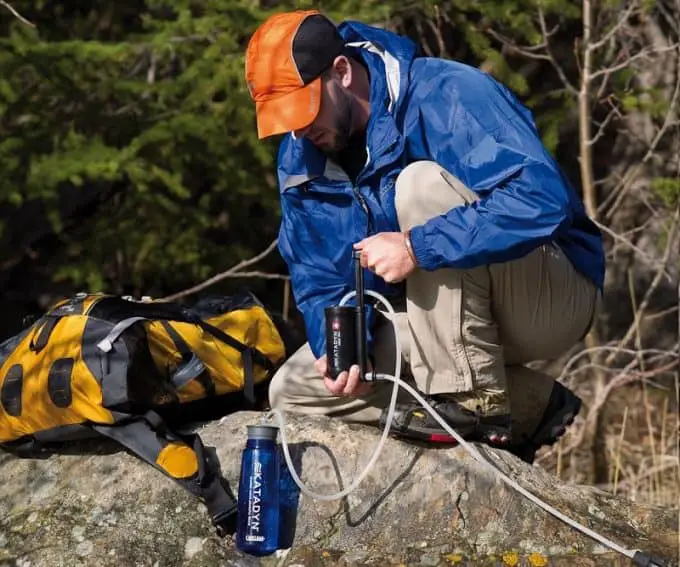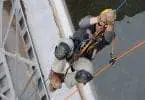If you’ve ever hiked or camped on a highly trafficked trail, you’ve no doubt heard horror stories of hikers who’ve contracted the dreadfully nasty Giardia or Norovirus. You might have even seen signs posted in privies or nearby towns detailing the horror of successive vomiting and seemingly unending diarrhea. You’ve also heard the ironic warning: stay hydrated. That’s why you need to know how to purify water.
See also: How to Stay Hydrated: Tips and Tricks Beyond Water and Bottles
These viruses and parasites are most often ingested through untreated drinking water, making the unpleasant illness that follows very preventable. Many folks think that as long as water is running or clear, then it’s probably fine to drink, but the truth is, drinking untreated water in the backcountry is always a risk.
In this article, we’ll focus on how to purify your own water as well as give a general overview on why it is important to have clean water, including the different types of filtering and chemical purification so you can choose the right water treatment system on your next adventure.
Considering Raw Water?
After a long, hot day of hiking, it may be tempting to throw down your pack and drink from a stream or pond. Even on a casual jaunt into the woods, there’s something freeing and poetic about cupping your hands in a stream of cold water that’s running over smooth rocks and talking a nice big gulp.
Raw water is the water that’s naturally found in an environment. It’s a result of rain, streams, rivers, and lakes and it hasn’t been treated, meaning it hasn’t had any minerals or living organisms removed. It’s great for watering crops, hydrating livestock, flushing toilets and cleaning cars, but it’s not okay for humans to drink.

Drinking raw water leaves you vulnerable to contaminants with big scary names like Cryptosporidium, Giardia Intestinalis, Campylobacteriosis, E. Coli, Norovirus, and to their really unpleasant consequences. The most common symptoms from all of the above include diarrhea, vomiting, and cramps, with the added potential for dehydration, which can be deadly if left untreated.
Water gets contaminated by either human or animal fecal waste, which in theory means that if you’re in a remote enough location (likely at a higher altitude too) where there isn’t much human or pack animal traffic, you’re taking less of a gamble by not treating your water than if you were to drink from somewhere along, say the Appalachian Trail.
But there’s no way to tell by sight if water is contaminated or not, so always purifying your water is the safest choice.
It’s important to understand some of the basics around the pathogens found in raw water. With this knowledge, you can decide which treatment method will serve your purposes best.
Water Borne Pathogens
Bacteria
Bacteria is the easiest type of pathogen to filter out because of their size and because they have difficulty surviving in water to begin with. Most filters and purification chemicals will be able to remove bacteria.
Example: E. Coli
Protozoa
Protozoa are single celled organisms that mainly live in water. They also have the ability to multiply in humans which helps them to survive and cause damage for a significant amount of time. Symptoms can occur anytime within two days and two weeks of contact. Not all purification methods will be able to remove all protozoans, especially Cryptosporidium

Example: Giardia
Viruses
Viruses are so tiny that the largest virus is smaller than the smallest bacteria. They are harder to detect in water and are carried easily in human and animal feces. Filtration is not effective on viruses; only chemical purification is.
Example: Norovirus.
Before diving into water purification technology, let’s talk about what to look for in a water source. The cleaner the water is to begin with, the more effective your filter or purifiers will be. Stay away from water that has a lot of sediment or is extremely murky unless you have no other options. If this can’t be avoided, there are prefilters that will help with distilling heavy amounts of sediment.
Why Use a Prefilter?
Pump filters often come with a prefilter. The role of the prefilter is to remove large particles from particularly murky water. Using a prefilter also helps to extend the life of the pump by maintaining the filter’s flow rate.
The less bogged down by large sediment, the better a chemical treatment will work as well. If you want to use a UV filter, it will only work if the water is prefiltered and clear.
Next we’ll talk about the two most effective ways to treat water: filtering and purifying. There are important technical and pathogen elimination differences between the two.
What Is a Filter?
Water is mechanically pushed through a filter’s internal cartridge which strains bacteria and protozoa out. Viruses, however, cannot be killed this way. Filters also often include activated carbon because it effectively strains out particulate matter, such as leaf debris, silt, dead bugs and dirt.
The activated carbon reduces the presence of other less than healthy contaminants, like industrial chemicals and removing particulate matter helps to improve the taste of the water.
A Note On Upkeep: Filters periodically have to be cleaned to keep the water flow running effectively. Eventually, they must be replaced as all the gunk they encounter will break down the filter.
“Micron size” is a term you’ll hear tossed about when shopping for filters. It’s the measurement of the pore size of the filter’s chosen medium (which we’ll get to in just a moment.) The smallest bacteria is 0.2 microns, which means your filter should have a similar micron size so it can filter out the smallest bacteria.
Types of Filter Mediums
There are four common types of filter medium, which is the material that the filter is made out of to catch the organisms and debris we don’t want to drink.
Ceramic
Ceramic filters are long lasting and are easy to scrape clean.
They can also come with a carbon core that we discussed previously. On the downside, they do clog easily.
Example: MSR EX Ceramic Element
Fiberglass
Fiberglass filters are more fragile than ceramic filters but are still very effective.

Example: Katadyn Vario
Hollow Fiber
Water is strained through tiny, hollow, U- shaped tubes that make up the core of this filter.

Example: MSR Hyperflow Microfilter
Silica Depth
This filter uses finely grained silica sand to filter water. There are multiple levels of different sized grains that range from largest to finest, enabling the filter to catch different sizes of debris and organisms.

Example: MSR SweetWater Microfilter
Now we’ll get into the different types of filters and what situations they’re best for.
Types of Filters
Straw Style Filters
The name says it all! It’s essentially a straw that enables you to drink directly from the water source. It’s efficient, light weight, and less costly than many other filtering options.
Cons: It’s best used for one person, there’s no way to take clean water with you, and field cleaning is required.
Example: LifeStraw Water Filter
Bottle Filters
Bottle filters are simple, quick, and best suited for the solo adventurer on a day trip. There is some variety as to how they filter, some have a UV light built into the bottle and others have a more traditional manual filter which activates when you suck on the bite valve.
After filling your water bottle directly, screw the cap on, and sip worry free! Bottle filters typically run cheaper than gravity filters and are also much lighter.

Cons: Water quantity is limited by bottle size and field cleaning is required.
Example: LifeStraw Go Filter Bottle
Squeeze Filters
Squeeze filters belong to the same family as bottle filters. The big difference being that you’re filling a small reservoir, attaching the filter to the top and squeezing the reservoir so that water is pushed through the filter as you drink. It’s cheaper, lighter weight and more packable option than the bottle filter.
Cons: Water quantity is limited by reservoir size and field cleaning is required.
Example: Sawyer Mini Water Filter
Pump Filters
If you are gathering a large amount of water- perhaps for a group of rambunctious scouts or for that night’s cooking and cleaning- you’ll want a filter that can gather a large amount of water and filter it quickly.
Pump filters are great because they have the flexibility of treating as much or as little water as needed. Simply drop the intake hose into the water source, (sources that pool, such as a lake, are great) and work the pump over your reservoir or bottle.

Cons: Price (chemicals are cheaper), weight, bulk, shallow water makes filling challenging, and the inevitable cleaning or repairing that often happens in the field.
Example: Katadyn Hiker Pro Water Filter
Gravity Filters
After you’ve filled up at a water source, you just need to find a place to hang up your gravity filter, such as a tree or an exposed beam in a lean to, and wait. Unlike the pump filter, you don’t have to work those already tired muscles with pumping and you can filter water for large groups at once.
Platypus GravityWorks Water Filter System
Cons: Slower than pumping, can run into difficulties finding a place to hang the reservoir, shallow water makes this method challenging, and field cleaning must be done.
Example: Platypus GravityWorks Water Filter System
What Are Chemical Purifiers?
Chemically purifying water eliminates viruses, bacteria and protozoa that are too small for filters to cull out. It’s worth checking the label to see what specific pathogens it’s unable to eliminate though. Cryptosporidium is a common protozoan that is not always eliminated with chemical purifiers. The taste of the chemicals can also alter the taste of the water, which is a detraction for some.
Purifiers do not have the immediacy of a filter. Once water is filtered, you can immediately drink it. Purifiers tend to have a wait time from anywhere to 90 seconds or 20 minutes. If you’re camping somewhere for the night and time isn’t much of a concern, then the time lapse won’t be much of a consideration, neither would weight.
In that situation, you can afford to pack a high capacity filter and a water treatment that takes a bit longer. If you’re long distance backpacking, a UV light and a handheld, personal use filter would be a lighter and time efficient option.
Types of Purifiers
UV Light
UV Purifiers are another option, perhaps the most effective against pathogens. UV treatments scramble the DNA of the organisms, so they cannot reproduce inside your body but the light does not actually kill them. They’re lightweight and simple enough to use- push a button and stir. The UV light turns itself off after 60 seconds, rendering the water potable.
Other considerations: If only using a UV purifier, the particulate matter will remain in your water. It’s recommended to either filter before using the UV purifier or using the UV purifier on a clear running water source.
Use Care: Leaving your purified water in direct sunlight for an extended period of time, can reactivate the organisms.
Cons: Requires batteries and would be tedious if you have a large quantity of water to purify.
Example: SteriPen Ultra Water Purifier
There are two main chemicals on the market for water purification- iodine and chlorine. They can come in a few different combinations and are usually in the form of pills or drops.
Iodine
Iodine kills bacteria, protozoa and viruses. The tablets are very portable and you can get many uses out of them. Two tablets equal one quart of water and bottles usually come with fifty tablets in total. Unopened bottles should remain effective for about four years.
Cons: Chemical taste, which can be combatted by taste neutralizing tablets, iodine isn’t effective against Cryptosporidium and can be a concern for those with Thyroid problems or are pregnant. Wait time before drinking is 30 minutes and opened bottles should not be kept for more than one year.
Example: Potable Aqua Iodine and Taste Neutralize Tablets
Chlorine Dioxide
Chlorine dioxide is effective in all types of water- clear, muddy, warm or cold and without much of an aftertaste. It’s been around since the 1940s and kills 99.9% of bacteria and viruses including Giardia and Cryptosporidium.
The Aquamira brand has a two-part system where you mix drops (Part A and Part B) before introducing it to the water. Small size and long shelf life make it an easy investment and light weight option. One kit treats about 30 gallons of water.
Cons: Wait time for parts A and B to mix together and then for the combined solution to purify the water.
Example: Aquamira
It’s important to note that neither system-filtration or chemical purification- is 100% effective and as a failsafe, and it is highly recommended that one carries both a filter and a purifier.
Other Purifying Options
There are a few more water filtration options available that harness the natural elements to clean water.
Boiling
A trusted standard and handy backup if nothing else, bring your water to a boil for one minute before drinking. Regardless of the amount of particulate matter in the water, it will be clean if not clear.
Cons: Need to factor in enough fuel and time needed for boiling and cooling.
Solar Radiation
In an emergency situation, the CDC recommends the use of solar radiation. After filling a clear water bottle, lie it on a reflective surface like aluminum foil for six hours in direct sunlight. If the water is cloudy, this technique will not be effective.
Cons: A lengthy time commitment, need proper weather conditions, clear water and a reflective surface.
Best Practices for Clean Water
- To ensure you’re getting the cleanest water possible, it’s always a good idea to follow the directions your filter or purifying tablets come with and bringing these into the field.
- To avoid cross contamination, designate “dirty” and “clean” water receptacles. Label them when they’re empty to avoid confusion.
- Keep your hands as clean as possible, hand sanitizer is easy to pack along on any outdoor adventure.
- Wipe off the mouth of water bottles with a clean cloth before refilling them with clean water.
- Backwash your water filter as often as directed.
- Test UV filters before heading into the backcountry so you aren’t stuck without a new bulb or battery.
- Write the year purchased on the bottles of your chemical purifiers so you know when they are expired.
Always follow Leave No Trace principles when it comes to disposing waste and washing dishes.
Do not be the cause of a norovirus or giardia outbreak. Human waste should be buried 6-8 inches deep and 200 feet away from camp, water and trails. When washing, carry water 200 feet away from water sources and scatter strained dish water.
Going with the Flow
Maybe you’re not worried about water scarcity or weight and you’re thinking a pump filter is the way to go. With some iodine drops too, just in case. Maybe you’re concerned with getting water for a whole crew of people and are realizing a straw filter looks cool but won’t do for this trip. For the best backpacking water filters you can use, see our earlier piece to help you.
What’s most important to remember is that the safest option for clean water is to both filter and purify with chemicals, but how you do so is really up to you and your backcountry plans. So how do you purify water while you’re on the trail?
For more lifesaving backpacking tips, see our must-read piece on this important topic.
Featured Image Source: https://unsplash.com/photos/hR_mrZU6ndg








